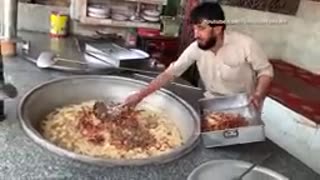Premium Only Content

Safety in the Kitchen_ Chopping Boards _ understanding Dirty Cloths
### **Safety in the Kitchen: Chopping Boards and Dirty Cloths**
Maintaining a safe kitchen environment is critical to prevent cross-contamination and ensure food safety. Two major culprits for spreading harmful bacteria are **chopping boards** and **dirty cleaning cloths**. Here’s how to manage these effectively:
---
### **Chopping Boards: Key Risks and Safety Practices**
#### **Why Chopping Boards are a Risk**
- **Cross-Contamination**: Raw food residue, like juices from raw meat or fish, can transfer bacteria (e.g., Salmonella, Campylobacter) to ready-to-eat foods.
- **Hidden Bacteria**: Deep scratches, grooves, and cracks in chopping boards can harbor bacteria, making cleaning ineffective.
- **Allergens**: Trace allergens left on boards can be dangerous for customers with food allergies.
#### **Best Practices for Chopping Boards**
1. **Use Colour-Coded Boards**:
Assign specific colours for different food types:
- **Red**: Raw meat
- **Blue**: Raw fish
- **Yellow**: Cooked food
- **Green**: Vegetables and salads
- **White**: Dairy and bakery items
This prevents accidental cross-use between food types.
2. **Clean After Each Use**:
- Scrub boards thoroughly with hot, soapy water immediately after use.
- Sanitize with a food-safe disinfectant to kill bacteria.
3. **Check for Damage**:
- Inspect boards regularly for cracks, grooves, or excessive wear.
- Replace boards showing signs of damage, as these areas can trap bacteria.
4. **Separate Boards for Allergens**:
- Use separate, clearly marked boards for foods containing allergens like nuts or gluten to avoid cross-contact.
5. **Storage**:
- Store boards vertically to ensure they dry thoroughly, preventing moisture build-up, which encourages bacterial growth.
---
### **Dirty Cloths: Key Risks and Safety Practices**
#### **Why Dirty Cloths are a Risk**
- **Spread of Bacteria**: Cleaning cloths used repeatedly without washing can transfer bacteria from one surface to another.
- **Moisture**: Damp cloths are a breeding ground for bacteria.
- **Cross-Contamination**: Using the same cloth for multiple tasks (e.g., wiping a raw meat surface and a prep area) spreads contaminants.
#### **Best Practices for Cleaning Cloths**
1. **Use Disposable Cloths**:
- Single-use, disposable cloths are the safest option to prevent bacterial spread.
2. **Wash Reusable Cloths Properly**:
- Launder cloths at high temperatures (at least 60°C) after every use.
- Avoid reusing cloths without washing them first.
3. **Keep Tasks Separate**:
- Assign specific cloths for different tasks, such as:
- One for cleaning raw meat surfaces.
- Another for wiping ready-to-eat prep areas.
- Colour-code cloths (e.g., red for raw meat areas, blue for general surfaces) to minimize mistakes.
4. **Sanitize Cloths During Use**:
- Soak cloths in a food-safe sanitizer between uses to reduce bacterial build-up.
5. **Dry Cloths Thoroughly**:
- Allow cloths to dry completely before reuse to discourage bacterial growth.
---
### **Practical Tips for Kitchen Safety**
#### **Chopping Boards and Cloth Management Together**
- **Cleaning Schedule**: Implement a cleaning schedule that includes chopping boards and cloths. Use checklists to track cleaning frequency and ensure compliance.
- **Training**: Train staff to understand the risks and follow best practices, such as:
- Switching cloths and boards during tasks.
- Cleaning and sanitizing equipment immediately after use.
- **Regular Inspections**: Supervisors should regularly inspect chopping boards and cleaning materials for wear, cleanliness, and proper use.
#### **The Role of SFBB in Kitchen Safety**
- Use the **Safer Food Better Business (SFBB)** pack to establish documented procedures for managing equipment hygiene.
- Record cleaning tasks, training, and monitoring to demonstrate compliance during inspections.
---
### **What to Avoid**
1. **Mixing Raw and Ready-to-Eat Prep Areas**: Always keep separate equipment and cloths for these zones.
2. **Using Worn Equipment**: Replace boards and cloths as soon as they show signs of wear.
3. **Skipping Cleaning Steps**: Rinse, clean, sanitize, and dry—don’t skip any steps.
---
By managing chopping boards and cleaning cloths effectively, you can greatly reduce the risk of cross-contamination and ensure a safer kitchen environment.
Would you like a **custom cleaning checklist** for your kitchen or further advice on training your staff?
-
 20:24
20:24
HSESafetyInformation
7 months agoKABULI PULAO RECIPE - Original 40+ KG Afghani Meat Pulau Prepared - Street Food Qabili Plav Recipe_2
35 -
 LIVE
LIVE
Barneyjack
3 hours agoWarframe LR5/MR35 Gaming, Mayhem & Fashion!! Get in here :) :)
54 watching -
 30:00
30:00
BEK TV
4 days agoGUT HEALTH AND THE POWER OF KIMCHI WITH KIM BRIGHT ON TRENT ON THE LOOS
74.6K6 -
 12:00
12:00
Ken LaCorte: Elephants in Rooms
1 day ago $0.14 earnedWhy Don't Asians Commit Crimes?
3.7K4 -
 23:19
23:19
marcushouse
1 day ago $1.13 earnedStarship Flight 11 Is NOT What We Expected… 🚀
3.42K4 -
 22:06
22:06
Jasmin Laine
1 day ago"It’s An EMBARRASSMENT!"–David Eby Gets WRECKED by Former Liberal MP
3.72K20 -
 20:20
20:20
BlackDiamondGunsandGear
2 hours agoHas Glock been DETHRONED? / Best CCW Smith & Wesson Carry Comp
2.13K2 -
 52:10
52:10
NAG Podcast
1 day agoBrian Krassenstein: BOLDTALK with Angela Belcamino
1.91K9 -
 16:23
16:23
Gun Drummer
1 day agoEnglish band shoots guns for the first time
1.14K2 -
 36:44
36:44
Steph & Kayls
2 days ago $0.01 earnedMom, Dad & The Money: OF Finances 🌶️ | Ep.13
565
